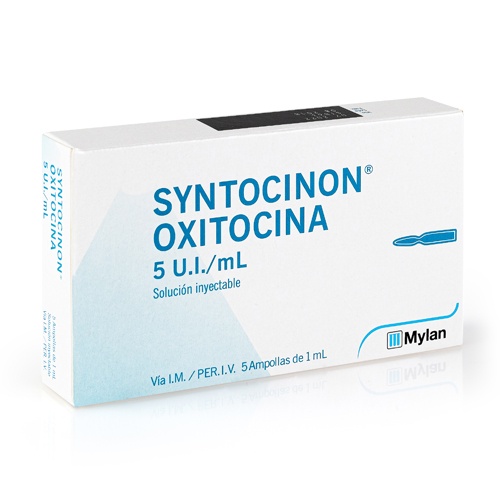

SYNTOCINON 10 UI/mL Solução Injetável e para Perfusão

Pergunte a um médico sobre a prescrição de SYNTOCINON 10 UI/mL Solução Injetável e para Perfusão

Como usar SYNTOCINON 10 UI/mL Solução Injetável e para Perfusão
Introdução
Prospecto: informação para o paciente
Syntocinon 10 UI/ml solução injetável e para perfusão
oxitocina
Leia todo o prospecto detenidamente antes de começar a usar este medicamento, porque contém informações importantes para si.
- Conserva este prospecto, porque pode ter que voltar a lê-lo.
- Se tiver alguma dúvida, consulte o seu médico ou enfermeiro.
- Se experimentar efeitos adversos, consulte o seu médico ou farmacêutico, mesmo que se trate de efeitos adversos que não aparecem neste prospecto. Ver seção 4.
Conteúdo do prospecto:
- O que é Syntocinon e para que é utilizado
- O que precisa saber antes de começar a usar Syntocinon
- Como usar Syntocinon
- Possíveis efeitos adversos
- Conservação de Syntocinon
- Conteúdo do envase e informação adicional
1. O que é Syntocinon e para que é utilizado
Syntocinon apresenta-se em forma de solução injetável e para perfusão.
Syntocinon pertence ao grupo de medicamentos denominados oxitócicos (medicamentos que favorecem o parto estimulando as contrações do útero). A ação que se produz é idêntica à produzida pela oxitocina, uma hormona natural liberada pelas glândulas pituitárias.
Syntocinon está indicado nos seguintes casos:
- Indução do parto a termo.
- Estímulo de contractibilidade em casos de inércia uterina.
- Prevenção e tratamento da hemorragia pós-parto.
2. O que precisa saber antes de começar a usar Syntocinon
Não use Syntocinon:
- se é alérgico à oxitocina ou a algum dos outros componentes deste medicamento (incluídos na seção 6).
- se o feto apresenta desproporção cefalopélvica, apresentação anormal.
- se existe predisposição a embolia por líquido amniótico (feto morto no útero, desprendimento prematuro de placenta).
- se você tem antecedentes de cesárea ou qualquer ato quirúrgico que afete o útero, placenta previa, vasa previa, contrações hipertônicas.
- se existe sofrimento fetal e se não é iminente o nascimento.
- se está a ser administrado de forma conjunta prostaglandinas ou outros estimulantes das contrações uterinas e em qualquer caso, devem ter decorrido pelo menos seis horas desde a administração daquelas.
- Em caso de parto múltiplo.
Advertências e precauções
Consulte o seu médico ou enfermeiro antes de começar a usar Syntocinon.
A utilização de oxitocina para indução ao parto deve realizar-se estritamente por razões médicas, não por conveniência.
Syntocinon não deve ser utilizado durante períodos prolongados em pacientes com inércia uterina resistente à oxitocina, toxemia pré-eclâmptica severa ou distúrbios cardiovasculares graves.
Deve ter especial precaução na presença de desproporção cefalopélvica limite, inércia uterina secundária, graus leves ou moderados de hipertensão induzida por gravidez ou doença cardíaca, e em pacientes maiores de 35 anos ou com antecedentes de cesárea do segmento uterino inferior.
Distúrbios cardiovasculares
Para evitar alterações significativas na pressão arterial e na frequência cardíaca, Syntocinon deve ser utilizado com precaução em pacientes com doenças cardiovasculares pré-existentes (como miocardiopatia hipertrófica, doença valvular cardíaca e/ou cardiopatia isquémica, incluindo vasoespasmo das artérias coronárias). Comunique ao seu médico se possui alguma dessas doenças.
Síndrome QT
Syntocinon deve ser administrado com precaução a pacientes com síndrome de QT longo ou sintomas relacionados e a pacientes em tratamento com medicamentos que se sabe que prolongam o intervalo QT (ver “Uso de Syntocinon com outros medicamentos”).
Sofrimento e morte fetal
A administração de oxitocina a doses excessivas produz uma sobre-estimulação uterina que pode causar sofrimento fetal, asfixia e morte, ou pode conduzir à hipertonicidade, contrações tetânicas ou ruptura do útero. O seu médico a submeterá a uma monitorização da frequência cardíaca fetal e da motilidade uterina.
Coagulação intravascular disseminada (CID):
Em raros casos, a indução farmacológica do parto mediante agentes uterotónicos, incluindo a oxitocina, aumenta o risco de aparecimento de CID pós-parto. Este risco aumenta particularmente em mulheres que têm fatores de risco adicionais para a CID, como ter 35 anos ou mais, complicações durante a gravidez e período gestacional de mais de 40 semanas.
Intoxicação hídrica
Devido a que a oxitocina possui uma ligeira atividade antidiurética, a sua administração intravenosa prolongada a doses elevadas junto com grandes volumes de líquido, como podem ser o tratamento do aborto inevitável ou aborto diferido, ou no tratamento da hemorragia pós-parto, pode portanto causar intoxicação hídrica associada a hiponatremia. Deve ter especial precaução em pacientes com insuficiência renal grave, devido à possível retenção de água e acumulação de oxitocina.
Insuficiência renal
Deve ter especial precaução em pacientes com insuficiência renal grave, devido à possível retenção de água e acumulação de oxitocina.
Alergia ao látex
O princípio ativo de Syntocinon pode provocar uma reação alérgica grave (reação anafiláctica) em pacientes alérgicos ao látex. Informe o seu médico se é alérgico ao látex.
Crianças e adolescentes
Não foi estabelecida a segurança e eficácia de Syntocinon em crianças e adolescentes (menores de 18 anos de idade). Não se dispõe de dados.
Uso de Syntocinon com outros medicamentos:
Comunique ao seu médico se está utilizando, utilizou recentemente ou poderia ter que utilizar qualquer outro medicamento. Ciertos medicamentos podem interagir com Syntocinon, nestes casos pode que o seu médico mude a dose ou interrompa o tratamento com algum deles. Em particular:
- Anestésicos inhalados de grande poder utero-relaxante (como por exemplo, halotano, clorofórmio, etc.), porque pode diminuir o efeito de Syntocinon.
- Agentes vasopressores (medicamentos que produzem uma constrição nos vasos), porque Syntocinon pode potenciar o seu efeito e produzir uma hipertensão arterial severa durante o período pós-parto.
- Prostaglandinas ou outros estimulantes das contrações uterinas, porque Syntocinon pode potenciar o seu efeito (ver seção 2).
- Medicamentos que produzem prolongamento do intervalo QT (que causam batimentos irregulares do coração), porque Syntocinon pode potenciar este efeito.
- Anestesia caudal, quando administrada durante ou após o bloqueio caudal, Syntocinon pode potenciar o efeito pressor de agentes vasoconstritores simpaticomiméticos.
Gravidez, lactação e fertilidade
Os dados sobre um número limitado de gravidezes são indicativos de que a oxitocina na gravidez não mostra reações adversas, quando administrada de acordo com as indicações terapêuticas.
A oxitocina pode ser excretada em pequenas quantidades no leite materno. No entanto, não é provável que cause efeitos nocivos no recém-nascido, porque a oxitocina é inativada rapidamente no trato digestivo do bebê.
Condução e uso de máquinas
Não se dispõe de dados sobre os efeitos na capacidade para conduzir e utilizar máquinas
Syntocinon contém etanol (álcool) e sódio
Este medicamento contém 0,6% de etanol (álcool), que se corresponde a uma quantidade de 4,8 mg por ml, o que equivale a menos de um ml de cerveja ou de vinho. A pequena quantidade de álcool neste medicamento não tem qualquer efeito perceptível.
Este medicamento contém menos de 23 mg de sódio (1 mmol) por ml; isto é essencialmente “isento de sódio”.
3. Como usar Syntocinon
A oxitocina será sempre administrada em meio hospitalar e sob controle médico.
Indução do parto ou estímulo da contractibilidade uterina
Para a indução ao parto, será sempre administrada por via intravenosa.
O profissional de saúde controlará a velocidade de infusão, e empregará uma bomba de infusão ou equipamento similar (ver seção “Instruções para um uso correcto de Syntocinon”, no final deste prospecto).
A velocidade inicial de infusão costuma ser fixada entre 1-4 mUI/minuto (2-8 gotas/minuto). Pode ser aumentada gradualmente, a intervalos não inferiores a 20 minutos, até que se estabeleça um padrão de contrações semelhantes às de um parto normal, sendo a velocidade máxima recomendada de 20 mUI/minuto (40 gotas/minuto).
Em mulheres com um parto a termo em que não se tenham iniciado contrações regulares após administrar uma quantidade de oxitocina de 5 UI (equivalente a 500 ml da solução preparada segundo a seção “Instruções para um uso correcto de Syntocinon”), recomenda-se interromper a indução ao parto e repetir no dia seguinte, começando de novo a partir de uma dose de 1-4 mUI/minuto.
A dose deve ser ajustada em todo o momento à resposta individual. Para isso, você será vigilada cuidadosamente (frequência do coração do feto, pressão sanguínea, etc.). Em caso de hiperatividade uterina ou sofrimento fetal, a infusão será suspensa imediatamente.
Prevenção da hemorragia pós-parto
A dose habitual é de 5 UI por infusão intravenosa (5 UI diluídas em uma solução salina fisiológica) ou de 5 a 10 UI por via intramuscular após a expulsão da placenta.
Tratamento da hemorragia pós-parto
A dose habitual é de 5 UI por infusão intravenosa (5 UI diluídas em uma solução salina fisiológica) ou de 5 a 10 UI por via intramuscular, em casos graves, seguido de outra infusão intravenosa de uma solução que contenha 5-20 UI de oxitocina.
Se usa mais Syntocinon do que deve
Em caso de sobredose ou ingestão acidental, consulte o seu médico ou farmacêutico ou ligue para o Serviço de Informação Toxicológica. Telefone 915 620 420, indicando o medicamento e a quantidade utilizada.
Quando se apresentem sinais ou sintomas de sobredose durante a administração intravenosa contínua de Syntocinon, o seu médico deve interromper imediatamente a infusão e administrar oxigênio à mãe.
Em caso de intoxicação hídrica é essencial restringir a ingestão de líquidos, promover a diurese, corrigir o desequilíbrio eletrolítico, e controlar as convulsões que pudessem produzir-se.
4. Possíveis efeitos adversos
Como todos os medicamentos, este medicamento pode produzir efeitos adversos, embora nem todas as pessoas os sofram.
Foram comunicados os seguintes efeitos adversos. Os efeitos adversos estão classificados sob títulos de frequências, o mais frequente é indicado em primeiro lugar, utilizando a seguinte convenção: Muito frequentes (≥ 1/10); frequentes (≥ 1/100, <1>
Os efeitos adversos derivados da experiência pós-comercialização com Syntocinon foram obtidos através de notificações de casos espontâneos e casos descritos na literatura. Como estes efeitos adversos são reportados de forma voluntária por uma população de tamanho desconhecido, não é possível estimar de forma fiável a sua frequência, por isso são classificados como não conhecidos.
Tabela 1: Efeitos adversos na mãe
Classificação de órgãos e sistemas | Efeito adverso |
Distúrbios da sangue e do sistema linfático Frequência não conhecida: | Coagulação intravascular disseminada |
Distúrbios do sistema imunológico Raros: | Reações anafilácticas/anafilactoides associadas a dispneia e hipotensão; Choque anafiláctico/anafilactoide |
Distúrbios do metabolismo e da nutrição Frequência não conhecida: | Intoxicação hídrica, hiponatremia |
Distúrbios do sistema nervoso Frequentes: | Dor de cabeça |
Distúrbios cardíacos Frequentes: Pouco frequentes: Frequência não conhecida: | Taquicardia, bradicardia Arritmia Isquemia miocárdica, prolongamento do intervalo QT do eletrocardiograma |
Distúrbios vasculares Frequência não conhecida: | Hipotensão |
Distúrbios respiratórios, torácicos e mediastínicos Frequência não conhecida: | Edema pulmonar agudo |
Distúrbios gastrointestinais Frequentes: | Náuseas, vômitos |
Distúrbios da pele e do tecido subcutâneo Raros: Frequência não conhecida: | Erupção Angioedema |
Gravidez, puerpério e doenças perinatais Frequência não conhecida: | Hipertonia uterina, contrações tetânicas do útero, ruptura do útero |
Distúrbios gerais e alterações no local de administração Frequência não conhecida: | Rubor |
Tabela 2: Efeitos adversos no feto/recém-nascido
Classificação de órgãos e sistemas | Efeito adverso |
Distúrbios do metabolismo e da nutrição Frequência não conhecida: | Hiponatremia neonatal |
Gravidez, puerpério e doenças perinatais Frequência não conhecida: | Síndrome de sofrimento fetal, asfixia e morte |
Comunicação de efeitos adversos
Se observar qualquer tipo de efeito adverso, consulte o seu médico, farmacêutico ou enfermeiro, mesmo que se trate de possíveis efeitos adversos que não aparecem neste prospecto. Também pode comunicá-los directamente através do Sistema Espanhol de Farmacovigilância de Medicamentos de Uso Humano: www.notificaRAM.es. Mediante a comunicação de efeitos adversos, você pode contribuir para fornecer mais informações sobre a segurança deste medicamento.
5. Conservação de Syntocinon
- Mantenha este medicamento fora da vista e do alcance das crianças.
- Conservar no envase original na geladeira (entre 2 e 8 ºC). Não congelar.
- Conservar no envase original para protegê-lo da luz.
- Não utilize este medicamento após a data de validade que aparece no envase. A data de validade é o último dia do mês que se indica.
Os medicamentos não devem ser jogados fora pelos esgotos nem pela lixeira. Deposite os envases e os medicamentos que não precisa no ponto SIGRE da farmácia. Em caso de dúvida, pergunte ao seu farmacêutico como se livrar dos envases e dos medicamentos que não precisa. Desta forma, ajudará a proteger o meio ambiente.
6. Conteúdo do envase e informação adicional
Composição de Syntocinon
- O princípio ativo é oxitocina. Cada ml de solução contém 10 UI de oxitocina.
- Os outros componentes (excipientes) são etanol, acetato sódico tri-hidratado, clorobutanol, cloruro de sódio, ácido acético glacial, água para injeções.
Aspecto do produto e conteúdo do envase
Ampolas de vidro transparente que contêm 1 ml de uma solução clara, estéril e incolor.
Envase contendo 10 ampolas.
Titular da autorização de comercialização
Alfasigma S.p.A.
Via Ragazzi del ’99, n.5
40133 Bolonha. ITÁLIA
Responsável pela Fabricação:
Alfasigma, S.p.A.
Via Pontina Km 30.400
00071 Pomezia (Roma). ITÁLIA
Representante local:
Alfasigma España, S.L
C/ Aribau 195, 4º
08021 Barcelona. ESPANHA
Data da última revisão deste prospecto:fevereiro 2021
Esta informação está destinada apenas a profissionais do sector sanitário.
Instruções para um uso correcto de Syntocinon
Prepare a solução de oxitocina dissolvendo assépticamente uma ampola de 10 UI em 1.000 ml de soro salino fisiológico ou glicose 5%. Certifique-se, mediante agitação suave ou rotação do frasco, de que a mistura é homogênea (a solução contém 10 mUI/ml de oxitocina).
Instruções para a correcta abertura da ampola

Ampola quebrável. A linha de ruptura encontra-se por baixo do ponto colorido. Coloque o polegar por cima do ponto colorido e quebre a ampola pressionando para trás.
“A informação detalhada e actualizada deste medicamento está disponível na página Web da Agência Espanhola de Medicamentos e Produtos Sanitários (AEMPS) http://www.aemps.es/ ”
- País de registo
- Substância ativa
- Requer receita médicaSim
- Fabricante
- Esta informação é apenas para referência e não constitui aconselhamento médico. Consulte sempre um médico antes de tomar qualquer medicamento. A Oladoctor não se responsabiliza por decisões médicas baseadas neste conteúdo.
- Alternativas a SYNTOCINON 10 UI/mL Solução Injetável e para PerfusãoForma farmacêutica: INJETÁVEL, 16.7 µg/mlSubstância ativa: oxytocinFabricante: Fresenius Kabi España, S.A.U.Requer receita médicaForma farmacêutica: INJETÁVEL, 100 microgramasSubstância ativa: carbetocinFabricante: Gp Pharm S.A.Requer receita médicaForma farmacêutica: INJETÁVEL, 100 microgramas/mililitroSubstância ativa: carbetocinFabricante: Ferring S.A.Requer receita médica
Alternativas a SYNTOCINON 10 UI/mL Solução Injetável e para Perfusão noutros países
As melhores alternativas com o mesmo princípio ativo e efeito terapêutico.
Alternativa a SYNTOCINON 10 UI/mL Solução Injetável e para Perfusão em Польша
Alternativa a SYNTOCINON 10 UI/mL Solução Injetável e para Perfusão em Украина
Médicos online para SYNTOCINON 10 UI/mL Solução Injetável e para Perfusão
Avaliação de posologia, efeitos secundários, interações, contraindicações e renovação da receita de SYNTOCINON 10 UI/mL Solução Injetável e para Perfusão – sujeita a avaliação médica e regras locais.














